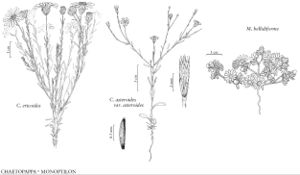Monoptilon
Boston J. Nat. Hist. 5: 106, plate 13, figs. 1–6. 1845.
| Taxon | Illustrator ⠉ | |
|---|---|---|
 | Chaetopappa ericoides Chaetopappa asteroides var. asteroides Monoptilon bellidiforme | Barbara Alongi Barbara Alongi Barbara Alongi |
Annuals, 1–5 cm, herbage hispido-hirsute (hairs long, white), minutely glandular; taprooted. Stems prostrate to decumbent (radiating from base), simple or branched. Leaves basal and cauline; alternate; petiolate; blades 1-nerved, oblong to oblanceolate-spatulate, margins entire (apices rounded to obtuse). Heads radiate, borne singly (usually immediately subtended and surrounded by distal leaves). Involucres campanulate, 4–6 × 6–7 mm. Phyllaries 10–14 in 1 (–2) series, appressed (purple-tipped), 1-nerved (midnerves raised-indurate, evident only in proximal 1/2; proximally convex, not keeled), linear-lanceolate, equal, margins herbaceous or scarious, faces hirsute. Receptacles flat, pitted, epaleate. Ray-florets 12–21, pistillate, fertile; corollas white or rose or purple-tinged (strongly coiling). Disc-florets 28–40, bisexual, fertile; corollas yellow (with prominent orange veins), tubes much shorter than narrowly tubular-funnelform, lobes 5, reflexed, lanceolate; style-branch appendages obtuse to truncate. Cypselae (brownish) obovoid, compressed, 2-ribbed, faces sparsely strigose; pappi persistent, in (1–) 2 series, short-toothed cups plus 1 apically plumose bristle or 8–15 inner, tawny white, barbellate, apically attenuate bristles plus outer of short, laciniate paleae. x = 8.
Distribution
sw United States, n Mexico
Discussion
Species 2 (2 in the flora).
Both species of Monoptilon are decumbent to prostrate, hispid annuals with campanulate involucres, white coiling rays, obovoid compressed cypselae, and chromosome number of 2n = 16. The genus was placed by G. L. Nesom (1994) as sister to Chaetopappa.
Selected References
None.
Lower Taxa
Key
| 1 | Stems yellow-green; phyllary margins herbaceous; disc corollas loosely strigose proximally; pappi scarious cups 0.1–0.4 mm plus 1 apically plumose bristle usually equaling disc corollas | Monoptilon bellidiforme |
| 1 | Stems often prominently reddish purple; phyllary margins proximally with sharply delimited, white-scarious portions, lacerate-ciliate at base; disc corollas glabrous or nearly so; pappi outer crowns of paleae or narrow squamellae 0.5–1 mm plus 8–15 barbellate inner bristles, length 1/3 – 1/2 disc corollas | Monoptilon bellioides |